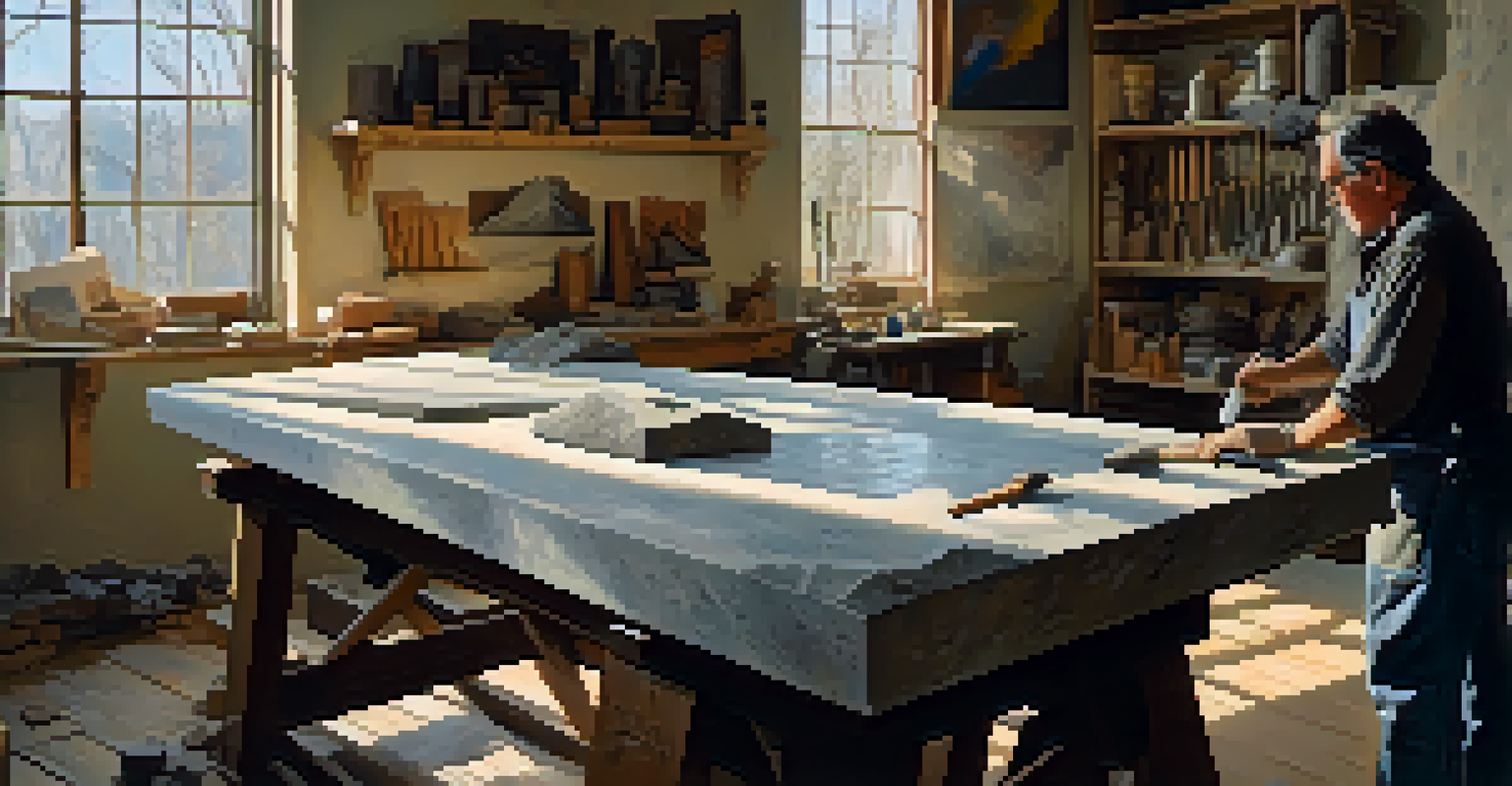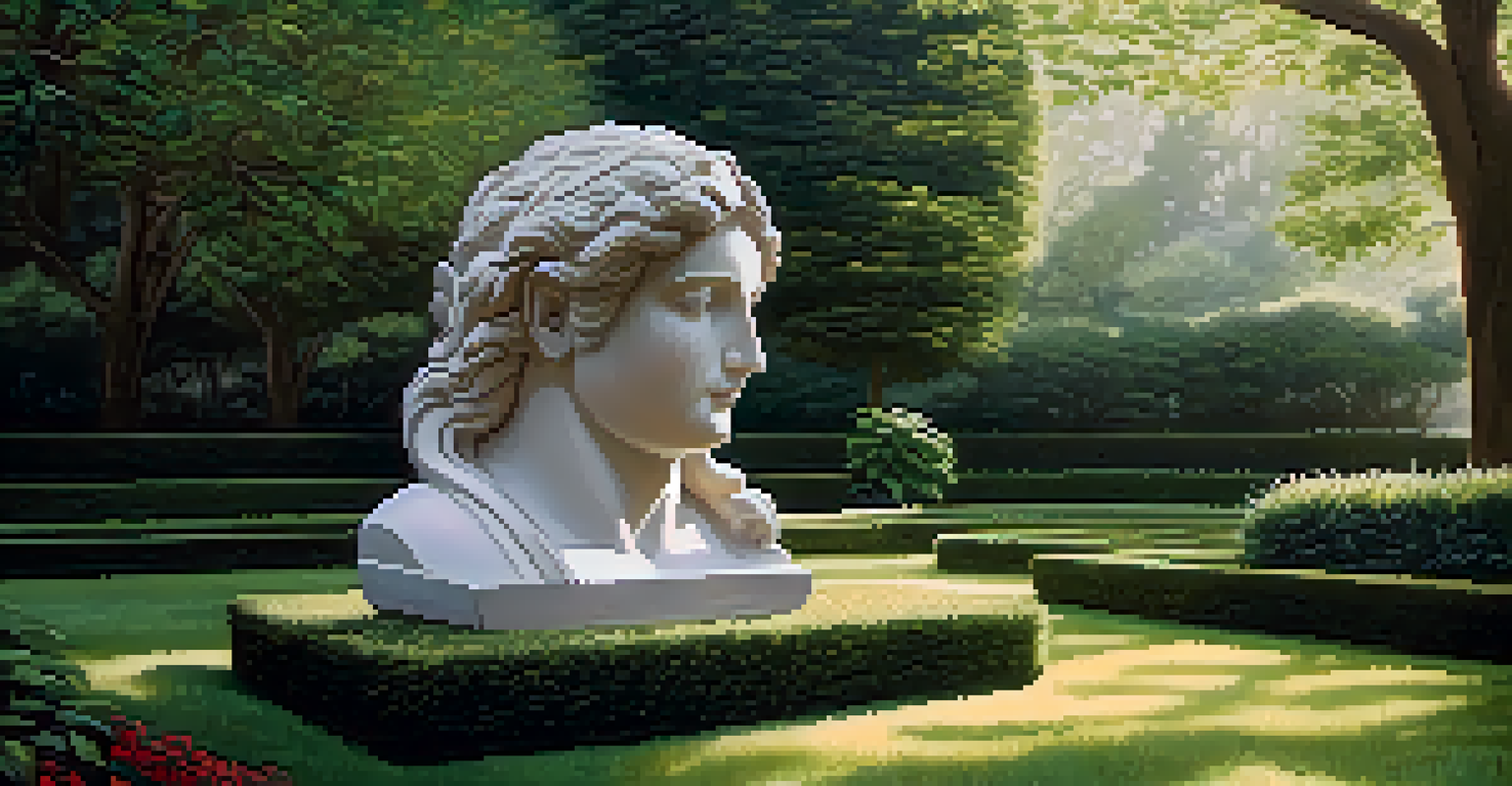The Role of Texture in Stone Carving: A Comprehensive Guide

Understanding Texture in Stone Carving: An Introduction
Texture is an essential aspect of stone carving that greatly affects the final appearance of a piece. It refers to the surface quality of the stone, which can range from smooth to rough, and plays a vital role in how light interacts with it. By manipulating texture, artists can evoke emotions and create depth, making their work more engaging and lifelike.
Art is the most beautiful of all lies.
In stone carving, texture is not just about aesthetics; it also influences the tactile experience. A rough surface might invite touch, while a polished finish can create a sense of elegance and refinement. Understanding the relationship between texture and form is crucial for any stone carver, as it enhances the overall narrative of their artwork.
As we delve deeper into the world of stone carving, it becomes apparent that texture is a powerful tool for expression. Artists often use it to convey movement, contrast, and even storytelling. This guide will explore the different textures available and how they can be effectively utilized in stone carving.
The Different Types of Texture in Stone Carving
Textures in stone carving can generally be categorized into three main types: natural, mechanical, and artistic. Natural textures are inherent to the stone, showcasing its unique character, such as the veining in marble or the rough surfaces of granite. Mechanical textures are created through tools and techniques, like chiseling or sanding, which allow artists to customize the surface to their vision.

Artistic textures, on the other hand, are the most creative and expressive. These can involve layering techniques, such as adding a patina or using contrasting materials to enhance visual interest. By combining different textural elements, stone carvers can produce complex surfaces that draw the viewer's eye and provoke thought.
Texture Shapes Stone Carving Art
Texture is a crucial element in stone carving, influencing both the aesthetic appeal and emotional resonance of the artwork.
Understanding these different types of textures can empower artists to make informed choices in their work. Each texture offers unique possibilities for expression and should be selected based on the intended message and emotional impact of the piece.
How Texture Affects Light and Shadow in Carving
One of the most fascinating aspects of texture in stone carving is its ability to manipulate light and shadow. The way light interacts with a textured surface can dramatically alter the perception of a sculpture. For instance, a rough surface can cast more shadows, creating depth, while a smooth finish reflects light and can appear more ethereal.
Every artist dips his brush in his own soul, and paints his own nature into his pictures.
This interplay between light and texture is crucial for stone carvers aiming to create dynamic pieces. By strategically choosing where to apply texture, artists can highlight certain features and guide the viewer's gaze. It’s a dance of illumination and obscurity that adds richness to the artwork.
Ultimately, understanding how texture influences light allows carvers to elevate their work from mere stone to a captivating visual experience. The thoughtful application of texture can invite viewers to engage with the piece on multiple levels, enhancing their appreciation.
Techniques for Creating Texture in Stone Carving
Creating texture in stone carving involves a variety of techniques that can be used alone or in combination. Traditional methods include chiseling, hammering, and sanding, each producing distinct effects. For example, chiseling can create deep grooves, while sanding smooths out surfaces to a fine finish, allowing for a more polished appearance.
Another technique involves using specialized tools, like rotary drills or grinders, which can achieve intricate patterns and finer details. These modern tools expand the possibilities for texture, enabling artists to experiment and innovate beyond traditional methods. The choice of technique often depends on the stone type and the desired outcome.
Techniques Enhance Textural Variety
Various techniques, from traditional chiseling to modern tools, allow artists to create diverse textures that enhance their creative expression.
Embracing various techniques for texture not only enhances the visual appeal of the carving but also allows for personal expression. Each artist can develop their signature style by mastering these methods and finding a balance that resonates with their artistic vision.
The Emotional Impact of Texture in Stone Art
Texture in stone carving goes beyond visual appeal; it can evoke strong emotions and connections. For instance, a rough, jagged surface might convey chaos or struggle, while a smooth, flowing texture may evoke calmness or serenity. By carefully considering texture, artists can communicate their intended message more effectively.
Artists often draw on personal experiences and emotions when selecting textures for their work. This connection can lead to pieces that resonate deeply with viewers, as they may find familiar feelings reflected in the textures used. A well-chosen texture can spark memories or feelings, enhancing the impact of the artwork.
Ultimately, the emotional impact of texture is a powerful aspect of stone carving. It transforms a static object into a narrative experience, inviting the audience to engage with the piece on a deeper level.
Maintaining Texture in Stone Carving: Tips and Tricks
Once a stone carving is complete, maintaining its texture becomes essential for preserving its beauty. Environmental factors like moisture, temperature, and sunlight can affect the stone and alter its texture over time. Regular cleaning and sealing can help protect the surface and keep it looking fresh.
Additionally, understanding the specific needs of the stone type is crucial for maintenance. Some stones may require more care than others, with softer materials being more susceptible to scratches and wear. Knowing how to care for each type of stone ensures that the textures remain vibrant and intact.
Maintenance Preserves Textural Beauty
Proper maintenance is essential for preserving the texture of stone carvings, ensuring their beauty and emotional impact endure over time.
Incorporating maintenance practices into the lifecycle of a stone carving allows artists and collectors to enjoy the work for years to come. A little care goes a long way in preserving the textures that make each piece unique.
Conclusion: The Lasting Importance of Texture in Stone Carving
Texture serves as a fundamental element in stone carving, influencing aesthetics, emotional resonance, and viewer interaction. Understanding and mastering texture allows artists to convey their messages with clarity and depth. It’s a vital component that can elevate a simple stone into a profound work of art.
As this guide has explored, the techniques and choices surrounding texture are diverse and impactful. Whether through traditional chiseling or modern tools, each texture tells a story and invites exploration. This interplay of techniques, materials, and emotions is what makes stone carving a captivating art form.

In conclusion, the role of texture in stone carving is not merely an afterthought; it is foundational to the art itself. Embracing this complexity allows both artists and viewers to appreciate the beauty and intricacies of stone in new and exciting ways.